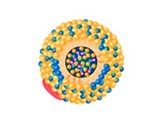Very-low-density lipoprotein (VLDL) is a type of lipoprotein synthesized by the liver, playing a critical role in lipid transport within the bloodstream. As one of the five major classes of lipoproteins, VLDL is primarily responsible for transporting triglycerides, cholesterol, and other lipids to various tissues in the body.
Structure and Composition
VLDL particles are relatively large, with diameters ranging from 30 to 80 nanometers. They are composed of approximately 90% lipids and 10% proteins, giving them a low density of 0.96 to 1.006 g/ml. The lipid component consists mainly of triglycerides (about 70% of the total mass), along with cholesterol esters and phospholipids. The protein component includes several apolipoproteins, notably apolipoprotein B-100 (apoB-100), which is essential for VLDL metabolism and receptor recognition, as well as apoC-I, apoC-II, apoC-III, and apoE, which play roles in lipid metabolism and transport.
Function of VLDL
The primary function of VLDL is to transport endogenous triglycerides and cholesterol from the liver to peripheral tissues, where they can be utilized for energy or stored. VLDL is crucial for maintaining lipid homeostasis in the body. Once released into the bloodstream, VLDL interacts with lipoprotein lipase (LPL) in capillary beds, where triglycerides are hydrolyzed, allowing fatty acids to enter tissues for energy production or storage. As triglycerides are removed, VLDL is converted into intermediate-density lipoprotein (IDL) and eventually low-density lipoprotein (LDL) as it loses triglyceride content and gains cholesterol.


